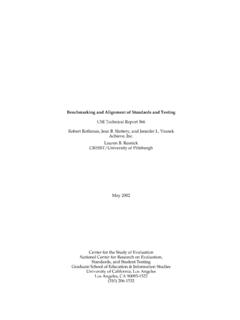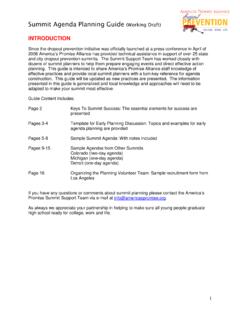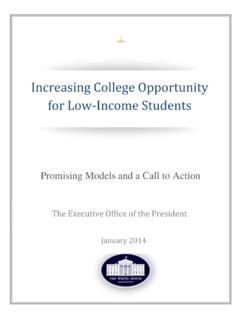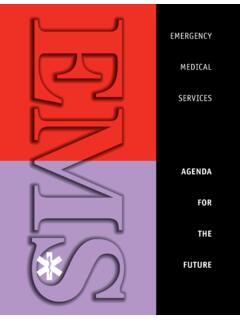Transcription of Communicating Internally and Externally - Achieve
1 1 2011 Communicating Internally and Externally Communicating clearly, frequently and with consistency is key to sustaining a successful college - and career-ready agenda in your state. Regardless of what your state has done so far to communicate about the college - and career-ready agenda , it is important to continually build on and build up your efforts and become more strategic to expand and maintain support statewide. Communicating with your internal core communications team first and then to those external audiences who need to be informed and/or influenced will be key.
2 Keeping such diverse groups informed, engaged, and ready and willing to do their part will be no small task. Establishing and adopting a communications plan to guide the how, who and when of your outreach efforts is the best way to keep your team on track, your message consistent and your voice heard. FIRST THINGS FIRST: Internal then External Communicating Internally among yourselves and the identified members of your communications team is where all communications efforts must begin. No campaign can be successful unless its own members and supporters are focused, energized and activated to help communicate the campaign s key themes and messages.
3 Once you have secured the understanding and support of your internal team, you can move your communications to the external audiences that you want to inform and/or influence. Internal communications strategies can include: Host regular in-person meetings with your core communications team; Schedule conference calls when you cannot meet in person to allow for information-sharing and brainstorming as a team; Send a regular update to your core team, which can be as simple as an email news alert or electronic newsletter; Establish an email distribution list of those principal internal people who must be reached out to frequently to ensure they are informed and on board with your efforts.
4 Send them relevant news coverage, new studies and reports, and other related materials. Using an email listserv is a no-cost way to keep other team members in the loop on current events and engaged; and Encourage team members to communicate within their organizations more broadly ( the department of education s communications director can send information to department staff on the college - and career-ready plans). The key to the internal then external communications strategy is to prevent any surprises for your team members and their staffs.
5 You never want one of your internal stakeholders to read about something you have done in the morning paper or hear about it first from a supervisor in their office. They are part of your team; make sure they feel like it and know it. Internal communications is also critical to ensure message discipline. If your team includes stakeholders from your state s governor s office, department of education and state chamber of commerce, the governor, state superintendent of education and executive director should be on the same page and on the same talking points whenever speaking publicly.
6 Once you have communicated Internally , then you can move to external audiences. 2 2011 Communicating Internally and Externally Moving From Internal To External Target audiences. After getting your internal house in order, you must now identify your supporters and your opposition. While you must understand your opposition and what motivates them against the college - and career-ready agenda , these are not the audiences to which you will be primarily Communicating . You must focus first on speaking to your supporters and understanding what messages and tactics move them to champion the agenda .
7 This will enable you to both grow your base of support and increase the intensity of your supporters. Start by simply listing the target audiences whose support you must gain and maintain. These likely include: Key legislators Key legislative committees The head of education agencies (K-12 and postsecondary) Key business and workforce leaders Key community groups in your state ( parent, civil rights, religious, non-profit groups it s important to determine who is listened to by others in your state) Students The media (Note: While the media is often considered a target audience, you are not really looking to gain or maintain the support of the media.)
8 The media is actually a vehicle through which you can reach and influence your target audiences, thus, it should be included on your list.) Next, you need to consider the messages that will motivate each audience. Sizing up the competition. In addition to target audiences, you should also consider the competitive environment in which you are executing your communications plan. What other groups/ organizations operate in your space? How do they sell their messages? What are they Communicating to your target audiences? You want to make sure that your messages and communications plan provide key differentiating benefits to drive your own relevance in the education reform debate.
9 Beyond like organizations with competing or overlapping missions, you must also take note of those organizations that may seek to advocate on behalf of a mission that is philosophically or politically at odds with your goals. While you may not be able to win them all over, knowing the opposition and their particular messages, audiences and level of influence is extremely important when crafting your own communications and outreach strategy. Key Messages: The Key Three You should be able to boil down what you want to communicate to three central messages the key three.
10 Typically, the first message will define the issue; the second will outline the problem; and the third will explain the solution. The key three should be distributed to all internal team members and communicated consistently, without variation, at all times. The discipline of repetition should be carried across all communication channels. And while you will develop sub-messages for each target audience, those sub-messages should fit under the key three, and those overarching messages should be communicated at all times by all leaders/members to all media.










